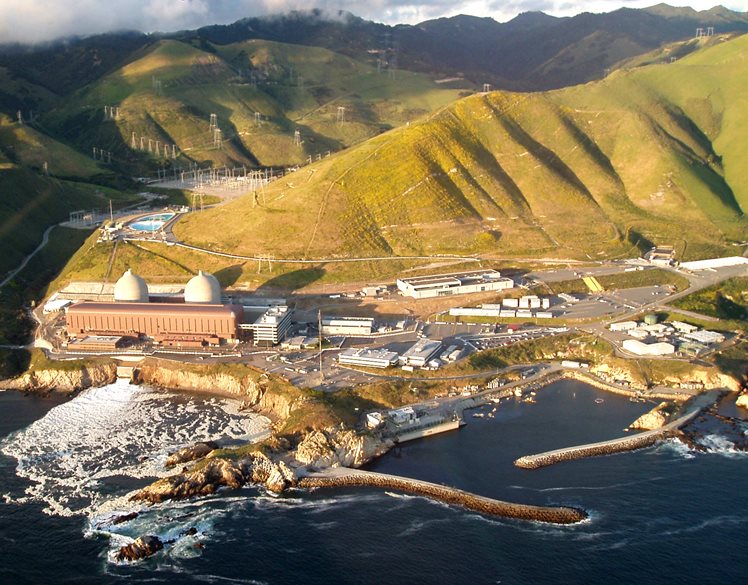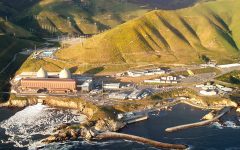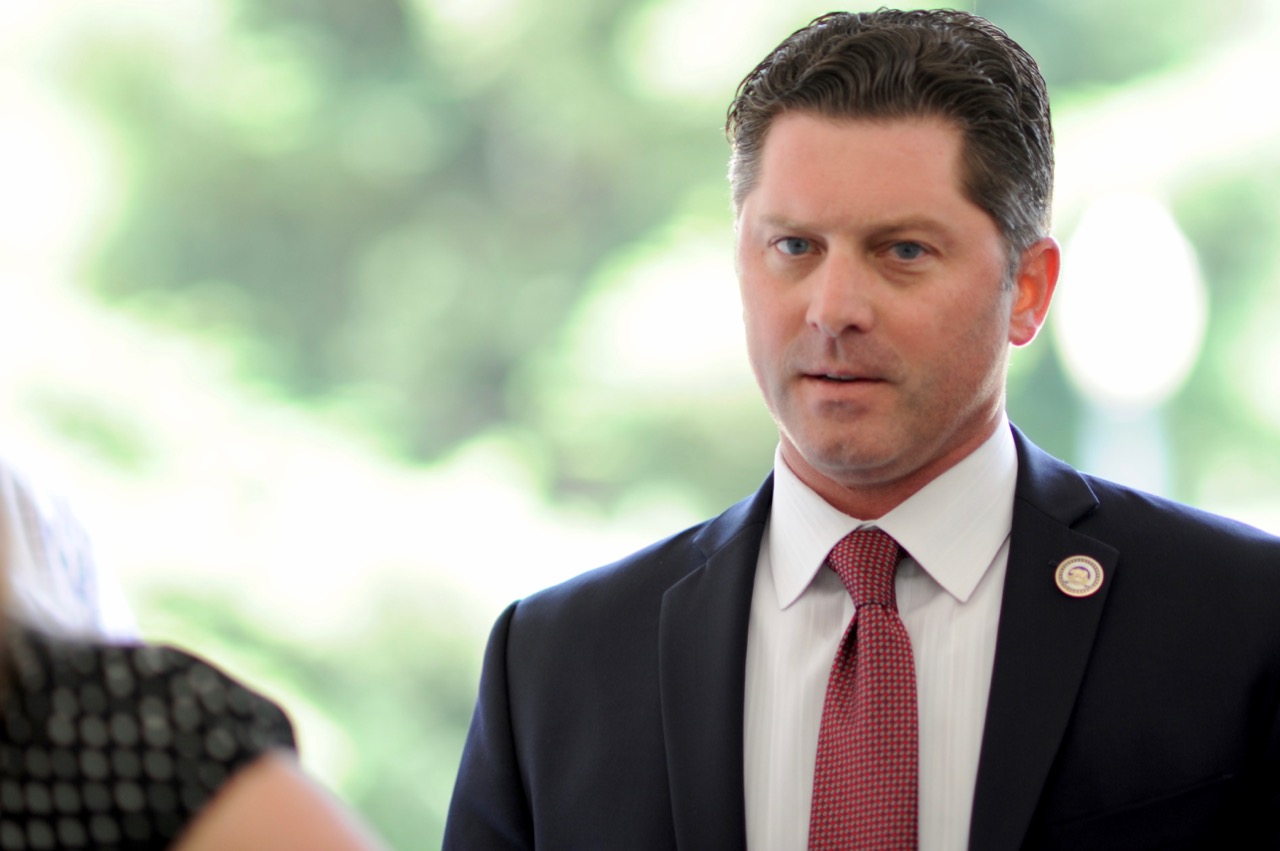
Diablo Canyon Nuclear Power Plant. (Photo: slocounty.ca.gov)
Grid Expert: Replacing Diablo Canyon Nuclear Plant with Renewables ‘Can’t Be Done’
To go 100% renewable would drive electricity prices four to five times higher
By Carl Wurtz, January 28, 2023 9:15 am
With recent legislation limiting the lifetime of California’s last remaining nuclear power plant to eight more years, the debate about replacement power has once again been thrust to the forefront of environmental concerns: will higher emissions after the shutdown of Diablo Canyon doom California’s efforts to meet climate targets?
Though generating electricity with nuclear power produces no CO2, California agencies believe the answer is “no.” Every five years the California Air Resources Board (CARB) develops a plan to determine what sources will be needed to deliver clean electricity to 30 million customers. And though California has set ambitious carbon reduction targets for 2030 and 2045, the only sources which qualify in CARB’s Scoping Plan fall under the arbitrary category of “renewable” energy. They include energy from solar panels, wind turbines, burning biomass (chipped lumber), and geothermal wells, but inexplicably neglect nuclear and hydroelectricity, which are actually America’s two largest sources of clean energy.
In 2016, when PG&E announced its decision close Diablo Canyon, the news was met with elation from large environmental groups. Calling the decision “historic”, the Natural Resources Defense Council was ebullient. “It is the first time any utility owner has committed to a plan to replace retiring nuclear generation with 100 percent, zero-emissions, clean electricity-generating [renewable] resources that are also lower cost,” read one press release. However, similar promises were never kept when California’s other nuclear plant, San Onofre, was closed in 2012. Its output was replaced by electricity from gas-fired power plants, driving state CO2 emissions 35% higher.
Keeping California’s grid running without power-on-demand from gas and nuclear power plants is a tall order. Intermittent power from solar and wind farms dramatically complicates grid management tasks for California’s Independent System Operator (CAISO), and though massive batteries have been deployed in hopes they might be able to smooth the rough edges of power from the sun and wind, improvements have been minimal. Too often, CAISO is forced to fall back on electricity from gas and out-of-state coal plants to keep the lights on.
Limitations of “Black Box” Computer Models
No electric grid in the world is currently powered by renewable energy and batteries alone. Yet California planners believe investment, together with help from computer models simulating how power flows might unfold in coming years, can make it happen.
Skeptics aren’t so sure. The model RESOLVE, from vendor Energy and Environmental Economics, Inc. (E3), serves as CARB’s grid-planning centerpiece. A “black box” computer model, RESOLVE spits out detailed solutions to grid planning problems – but like all predictions, they are dependent on what assumptions have been made about what will probably happen, in some probable situation. A maxim of computer science states that output from a computer model can be no better than its input (“garbage in, garbage out”).
What’s the input for RESOLVE, i.e., who are the programmers making those assumptions? E3’s website reveals only one of E3’s senior staff members has formal training in electrical engineering, with activities limited to work in New York and other eastern states. The model’s Product Manager has less than ten years of practical experience in designing energy systems, and is credited with one unpublished analysis sponsored by a solar panel manufacturer. Moreover, E3 offers no independent review of results delivered by RESOLVE. Does the model actually deliver on its promise of identifying “optimal long-term generation and transmission investments in an electric system”?
There is No Substitute For Experience
One of RESOLVE’s critics is Dr. Gene Preston, an expert in transmission adequacy studies and power supply reliability. His resume includes a Ph.D. in Electrical Engineering and a lifetime of experience working for the Electric Reliability Council of Texas (ERCOT), as well as consulting for utilities in the U.S. and abroad.
When I asked Preston whether Diablo Canyon could be replaced by renewables and batteries, his answer was unequivocal.
“No – can’t be done. Because December energy production of wind and solar is too low, it would require burning a lot of gas to compensate, and to go 100% renewable would drive electricity prices four to five times higher than what they are now. Missing from E3’s analysis are the cost and difficulty of building new transmission lines, especially those for offshore wind. The public will not stand for the number of new power lines needed to power California with just wind and solar from remote locations.”
Above all, Preston is a pragmatist. He believes models overcomplicate problems rooted in fundamental physics, and by doing so, can exacerbate them. In February 2021, when complications from Winter Storm Uri brought the Texas grid close to total collapse, Preston was one of the first experts contacted by ERCOT to determine what steps must be taken to avoid a recurrence.
“There still isn’t enough energy and enough battery storage to carry us through another storm Uri,” he maintains. “When ERCOT says, ‘we have an adequate system’, and we don’t have a storm Uri, then they’re probably telling the truth. But Uri is an exceptionally difficult problem for us. We’ll need 28 gigawatts of gas capacity during [another] Uri, and we still don’t know what the gas cost us in 2021. It was enormous. It literally wrecked our economy.”
On January 12 California’s Public Utilities Commission (CPUC) announced it would vote to determine whether Diablo Canyon Power Plant would be shut down permanently – even if its pending license renewal application is approved by the Nuclear Regulatory Commission, even if owner PG&E receives federal funding for the express purpose of keeping it open. Like San Onofre, there’s every indication shutdown will increase California CO2 emissions by 9 million tons, the equivalent of 1.7 million more cars on the road. Yet CPUC’s five commissioners – four attorneys and one administrator – will make one of the most consequential environmental decisions in California history. Their decision will be based on the output of black-box computer models, ones favoring outcomes that maintain reliance on gas-fired power plants indefinitely.
If that’s the best Californians can expect for their environmental future, it isn’t good enough.





Excellent article. I did a back of the napkin calculation on Newsom’s edict banning gas and diesel vehicle sales by 2035. Even if half the current registered cars in California are EV, and charging up just 50% of their battery capacity overnight, it would take about 20 Diablo Canyons
Why tf would every EV need to charge 50% every night.
Tell me you know nothing about EVs without telling me you know nothing about EVs.
Cause some people actually go to work?
Nuclear California???
Where we have earthquakes???
Can you spell Fukushima???
Fukushima was 1950’s nuclear technology. Modern, smaller reactors are safe and do not require seawater cooling like Diablo Canyon. Smaller modern reactors can be placed in low population areas away from earthquake fault lines and networked together like a computer network.
Your concerns about the potential for earthquakes to cause damage at Diablo Canyon are unfounded.
The seismicity of the site upon which Diablo Canyon sits has been studied more than any parcel in the world. It was chosen from over 100 sites along California’s coast for its distance from the San Andreas Fault (60 miles) and the lack of any active faults in the region.
Critics note, correctly, that two earthquake faults were found after construction (Shoreline and Hosgri). That was expected – there are earthquake faults crisscrossing the entire West Coast of the United States. But the possibility of these lesser faults causing damage at Diablo Canyon are vanishingly small. A comprehensive probabilistic risk assessment in 2018 determined the possibility of an earthquake causing core damage (a “meltdown”) at Diablo Canyon was once every 17,750 years. See: https://www.pge.com/en_US/safety/how-the-system-works/diablo-canyon-power-plant/seismic-safety-at-diablo-canyon/seismic-safety-at-diablo-canyon.page
For the past couple of decades, California’s annual power consumption has been about 300 tera Watt-hours (TWh) where a TWh is one billion kilo Watt – hours. Per the California DMV, the state currently has 40 million vehicles, the most in the nation. To power those vehicles with electricity (and residential appliance electrification) will require tripling California’s generation. For these additions to not harm the environment will require about 30 more Diablo Canyon Power Plants distributed along the California coastline. This is similar to the 2011 projections requested by the California Energy Commission of the California Council on Science and Technology, the state’s analogue to the National Academy of Sciences.
Amen, Carl. And “It’s worse than we thought!” The un-elected (who appointed these bozos anyway?) NRC has, I hear, just issued rules that will make it impossible to build any new nuclear, or upgrade existing.
We’re doomed. No need to ask anyone to “turn out the lights” hen leaving, they’ll already be off!
Having worked as failure analyst at Diablo Canyon, I am confident the plant is safe to use at least for another 10, probably 20 years, but the panic propagated by uninformed “the sky is falling ” proponents will most likely result in closing the plant prematurely. I did what I could. Hopefully the responsible “leaders” can inform themselves correctly before it is too late.
When all existing nuclear waste has been properly and safely disposed of I will revisit this issue.
All of these “ambitious targets” are made without any consideration to the PRACTICAL replacement systems, that would enable a rational transition…
What bugs the bajeezus out of us is that all these mandates and target dates are either WEF goals, or arbitrary, without ANY publicly communicated roadmaps as how we get from here to there, unscathed…
Newsom is Governor “Field Of Dreams”, operating under a “hope and change” mindset, without any logical, communicated plan…
But he doesn’t care, he thinks he’ll be in the White House by then, and someone else will figure it out…
And this jackwagon got re-elected legitimately??? I don’t think so…
Our over-looked & underutilized but most rapidly exploitable renewable energy resource is parking lots. Just follow France, by incentivizing & requiring solar canopies with integrated stationary storage batteries & vehicle-to-grid chargers on ALL existing parking lots with 80 or more spaces within 5 years, & within 3 years for big parking lots with hundreds of spaces. Do this before building more utility scale solar on remote farmland & environmentally sensitive habitat.
Reduce utility bills and transportation costs for tenants of leased commercial property, like large apartment & condominium developments, neighborhood shopping centers, business parks & public facilities. Produce & store reliable power right where most energy is consumed. Shade enormous asphalt heat islands. And accomplish all this without requiring expensive new long distance utility transmission infrastructure. These large parking lots will be the hubs of 1 to 2 mile radius micro grids networked across our typical lower density suburban neighborhoods. Widely distributed, cheap, reliable local power production & storage instead of remote, expensive, unreliable utility monopoly power.
This is not a utility or housing fix-all, but it can be accomplished very rapidly, everywhere, with existing standardized technology, expedited local permitting, & an existing trained workforce. Yes, the supporting canopies cost more than existing building roofs, but the area available is massively greater, and canopy structures will last for at least 75 years….That’s 3 successive generations of improving solar panels & batteries. Make this a state or local building ordinance, like fire sprinklers or parking requirements.
To replace required 24/7 base load power from fossil gas & aging nuclear plants, the western US has enormous widely distributed, untapped geothermal resources. Enhanced & Advanced Geothermal technologies are poised to replace existing fossil gas & aging nuclear plant with strategically distributed geothermal plants. Some geothermal plants are capable of being throttled, adding storage capacity to their base load capability. And some spent oil, gas & geothermal wells, of which there are many, can be similarly repurposed for energy storage. This is more expensive than solar, or maybe even off-shore wind, but there’s a lot to exploit, and we’ve only barely begun. Existing fossil fuel power is base load, but we will be replacing most of that with renewables + storage. The required proportion of base load power will be much, much less than our current system, perhaps as low as 30%, which would include hydro, bio-mass, geothermal & possibly some new nuclear sources.
100% renewable would drive CA electricity prices 4-5 times higher? Go to our Substack, you can see our shocked face. In this issue, https://envmental.substack.com/p/sacrificing-humanity-on-the-green-766
we compared CA electricity rates to GA electricity rates, CA renewable energy mandates to GA (lack of) same, and GA nuclear posture to CA nuclear posture.
The subtitle “Res Ipsa Loquitur” was self-evident after the analysis.